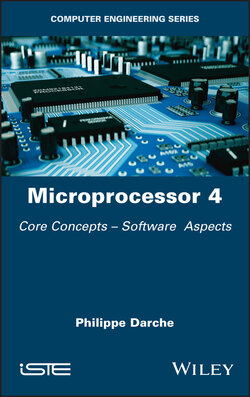Microprocessor 4

Реклама. ООО «ЛитРес», ИНН: 7719571260.
Оглавление
Philippe Darche. Microprocessor 4
Table of Contents
List of Illustrations
List of Tables
Guide
Pages
Microprocessor 4. Core Concepts – Software Aspects
Quotation
Preface
About the book
Multi-level organization
Introduction
1. Coding and Addressing Modes
1.1. Encoding and formatting an instruction
1.1.1. Code compression
1.2. Addressing modes
1.2.1. Immediate addressing
1.2.2. Register addressing
1.2.2.1. Explicit addressing
1.2.2.2. Implicit register addressing
1.2.3. Memory addressing modes
1.2.3.1. Direct addressing
1.2.3.2. Relative addressing
1.2.3.3. Indirect addressing
1.2.3.4. Indexed and based addressing modes
1.2.3.5. Combinations of addressing modes
1.2.4. Other addressing modes
1.2.4.1. Memory-to-memory addressing
1.2.4.2. (Implicit) stack addressing
1.2.4.3. Bit addressing
1.2.4.4. MMR addressing
1.2.4.5. Addressing modes specific to the digital signal processor
1.2.4.5.1. Circular addressing
1.2.4.5.2. Reverse bit order addressing
1.2.4.5.3. Linear addressing
1.2.4.6. Modes specific to the assembler
1.2.4.7. Obsolete modes
1.2.4.8. Note
1.2.5. Summary on addressing
1.3. Conclusion
2. Instruction Set and Class
2.1. Definitions
2.2. Transfer instructions
2.2.1. Data transfer
2.2.2. Address manipulation instructions
2.3. Data processing instructions
2.3.1. Arithmetic instructions for integers
2.3.2. Bit manipulation instructions
2.3.2.1. Preliminary definitions
2.3.2.2. Basic Boolean operators
2.3.2.3. Basic non-parallel manipulations
2.3.2.4. Advanced bit manipulation instructions
2.3.2.5. Advanced bit manipulation instructions
2.4. Control transfer instructions
2.4.1. Branchings
2.4.2. Conditional execution
2.4.3. Iteration control
2.4.4. Subroutine call and return instructions
2.5. Environmental instructions
2.5.1. Interrupt request and interrupt return instructions13
2.5.2. Stopping instructions
2.5.3. Processor management
2.5.4. Memory management
2.5.4.1. Cache management
2.5.4.2. TLB management
2.5.5. Hardware detection
2.5.6. Debugging
2.5.7. Updating
2.5.8. Verification
2.5.9. Various
2.6. Parallelism instructions
2.6.1. Atomic instructions
2.6.2. Synchronization instructions
2.7. Extensions to instruction sets
2.7.1. Multimedia extension
2.7.2. Extension for signal processing
2.7.3. Cryptography
2.7.4. Randomization management
2.7.5. Implications
2.8. Various instructions
2.8.1. Instructions for handling (strings of) characters
2.8.2. Input/output instructions
2.8.3. High-level instructions
2.8.4. Arithmetic instructions specific to a representation of particular numbers
2.8.4.1. Representation in BCD
2.8.4.2. Representation for real numbers
2.8.5. An unusual instruction
2.9. Conclusion
3. Additional Concepts
3.1. Concepts associated with the instruction set and programming
3.1.1. llegal, non-implemented, invalid, reserved and trusted instructions
3.1.2. Alignment or framing of instructions
3.1.3. Orthogonality and symmetry
3.1.4. Pure, re-entrant and relocatable codes and code for read-only memory
3.1.5. Levels of programming languages
3.2. Concepts linked to execution
3.2.1. Consequences for execution time and memory requirements
3.2.2. Execution modes
3.2.3. Portability
3.2.4. Virtualization
3.3. Hardware and software compatibilities
3.3.1. Hardware compatibility
3.3.2. Software compatibility
3.3.3. Upward and downward compatibilities
3.4. Measuring processor performances
3.4.1. Clock rate
3.4.2. Number of instructions per cycle
3.4.3. Execution time
3.4.4. Benchmark suites
3.4.5. Development of performances over time
3.5. Criteria for choosing
3.6. Conclusion
4. Subroutine
4.1. Stack memory
4.2. Subroutine
4.2.1. Nested calls
4.2.2. Execution context
4.2.3. Passing parameters and call conventions
4.3. Conclusion
5. Interrupt Mechanism
5.1. Origin, definition and classification
5.2. External causes
5.2.1. Execution context
5.2.2. Sources
5.2.3. Masking
5.2.4. Consideration and priority
5.2.5. Interrupt controller
5.3. Nested interrupts
5.4. Internal causes
5.5. Debugging
5.6. Priority between internal and external interrupts
5.7. Identification of the source and vectorization
5.8. Nested and queued interrupts
5.9. Uses
5.10. Interrupts and execution modes
5.11. Interrupts and advanced architectures
5.12. Conclusion
Conclusion of Volume 4
Exercises
Chapter 1. Exercises
Chapter 2. Exercises
Chapter 5. Exercises
Appendix. Tables for Encoding and Decoding Instructions
Acronyms
General
References
Preface and conclusion
Chapters 1 to 3
Chapters 4 and 5
Index
A
B
C
D
E
F
G
H
I
J
L
M
N
O
P
Q
R
S
T
U
V
W
WILEY END USER LICENSE AGREEMENT
Отрывок из книги
Series EditorJean-Charles Pomerol
.....
Figure 1.13. Seeking an operand in relative addressing
This mode can be seen as an indirect mode auto-incrementation using the PC (Program Counter) as an indirection register (cf. § 1.2.3.3).
.....